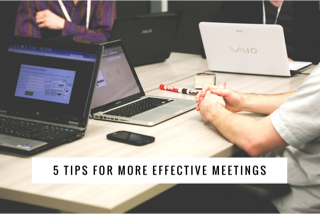
Nothing zaps the energy and enthusiasm out of your staff as quickly as a long, unproductive meeting. Employees walk away feeling that their time has been wasted, and management leaves asking if they made any progress. In an increasingly digital era face-to-face meetings are still important to the function of most businesses, but it’s highly important that you plan and conduct your meeting in the most efficient way possible. If you’re struggling with how to have effective meetings, implement these five strategies:
1. Write And Communicate An Agenda
Planning is the first step to having effective meetings, and it starts with your agenda. You need to take the time to sit down and write out each piece of information you need to divulge, or topic the team needs to discuss. This forces you to create a framework for the meeting that will help keep you from drifting too far from the intended purpose. Once you’ve completed your agenda, email it to all attendees ahead of time so they have a chance to go over it and prepare.
2. Cut The List Of Attendees
Employees see meetings as a waste of time when the information they hear is not relevant to their jobs. As you make your agenda, carefully consider whether or not all the topics apply to everyone in the room, and if they don’t, it’s time to cut the list of invitees. An optimal meeting size is between four and seven people.
3. Put The Devices Away
Meetings get derailed when employees spend more time on their smartphone or tablet than they do listening to what you have to say. People in the meetings become more distracted and the meeting can take longer than intended. People aren’t fully engaged, so they might also only get part of the information presented. When asked how to have effective meetings, almost every expert agrees that putting devices aside for the duration of the meeting is necessary. Email and notifications can wait, especially if you streamline your agenda and keep your meeting as short as possible.
4. Start and End On Time
If the clock hits the meeting start time and you’re not already discussing the first topic on the agenda, you’ve lost the room. Each second that passes feels more and more wasted, and by the time five minutes have gone by, your staff is partially tuned out. You can also lose them when a meeting begins to drag on, and they wonder why you haven’t finished. Show your staff that you respect their time by adhering to a strict policy of meeting start and end times, and they will respect you by arriving on time, prepared to work.
5. Follow Up Via Email
One of the biggest time wasters in a meeting is the question and answer period at the end where you allow employees to seek points of clarification about meeting topics. While it seems like a good idea to open the floor for discussion, what you’re really doing is ditching your written agenda at the very last minute. Employees should feel free to ask important questions, but you should encourage them to ask most questions via email to avoid using everyone else’s time to address one person’s issue.
It can sometimes be a struggle to have effective meetings, and it may require a change in company culture to get the results you want from your meetings. But when you do, you’ll wind up with a more engaged, informed and enthusiastic team, and no one will have to waste time in unnecessary meetings.




